Case study of DH
Male, Caucasian, born 1972
DH is a physically thin Chef (currently unemployed). He presented complaining of a constantly present pain between 5/10 and 10/10 in the mid and upper thoracic spine extending into the left sub-scapular region.
Symptoms noted included moderate positional dyspnoea and constant minor dyspnoea, almost complete movement restriction throughout the cervico-thoracic spine, and 50% restricted abduction and extension of the left shoulder.
Other symptoms included constant headaches and moderate but constant lower back pain. All symptoms were instantly aggravated by any level of activity.
Physical history: 25-10-98, DH fell on a set of concrete stairs, impacting the left vertebral and paravertebral regions at around the T6-7 level after losing his footing and having the feet accelerate down the staircase.
Radiographic examination revealed an equivocal and doubtful (by the x-ray report 12-98) left scapular fracture and possible Sheurmann’s disease at the lumbo-thoracic juncture.
DH tried regimes of physiotherapy, hydrotherapy etc by multiple practitioners with little improvement in condition. He presented March 31st, 2000 for a thermal image.
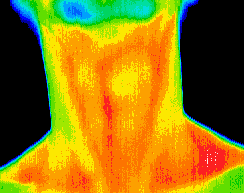
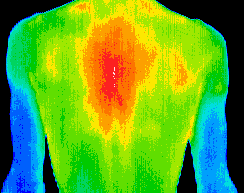
Anterior cervical region Mid axial region
The left brachial triangle exhibits a clear hyperthermic asymmetry. The reader can see the left sided paravertebral central hyperthermic pattern focused in the T5-6 region, with concentric decreasing hyperthermic radiation.
The hyperthermia noted following the costal fall line to the right of the superior extremity of the primary focus has in a large number of instances been correlated to a functional rotation in the thoracic cage.
For this to be in true, a rotation in the articulating vertebra would have to be seen, with subsequent functional irritation in these vertebrae, and a complementary pattern in the A-P opposite contra-lateral aspect.
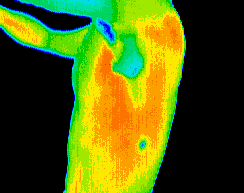
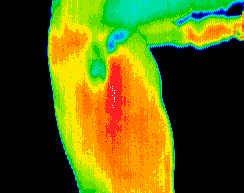
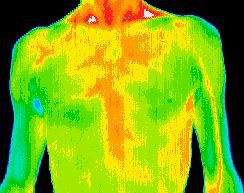
Lateral left chest Lateral right chest Anterior Chest
The reader will note that this person has a complementary pattern fulfilling the criteria for a probable functional rotation subluxation of a costal section.
One week after an initial treatment by a myotherapist aimed exclusively at treating the section of the vertebral column and ribs as described for the suspected rotation subluxation, the patient reported a 60% across the board improvement.
Below, you can see repeated (left) the original posterior chest image, and the image taken 1 week after the initial treatment.
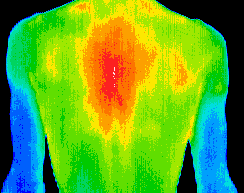
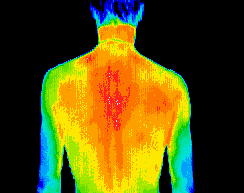
The discreet focus of the hyperthermic pattern dominating the original image has altered, losing the discreet singular focus. The extended apparent hyperthermic patterns can be seen in the original image, and are more apparent in
the second image due to the decrease in temperature gradient across the event. This patient has now had a third treatment, and reports a better than 85% improvement in all symptoms.
Conclusion
This study demonstrates:
• Thermography’s ability to detect a stable thermal asymmetry.
• Thermography’s ability to lead an analysis of a patient’s problem in a direction, based upon physiological evidence without ignoring the fact that the Thermogram is incapable of determining exactly (diagnosing) the nature of a problem. This highlights the role of Thermography as a complementary assessment tool, helping greatly the analytical process.
• The ability of Thermographic imaging to quantify changes in a patient’s physiology which coincides directly with the reported symptomatic alterations.
• A minor hyperthermic trace contra-laterally and A-P opposed, with a paravertebral hyperthermic focus can be a clinical marker for a functional costal rotation.
The matters raised in this case history regarding the thermographic signature of functional costal rotation is based upon approx 40 correlative studies where the images showed this pattern, and physical examination showed in all but 1 case, there was an associated costal rotation coinciding reliably with the thermographic findings.